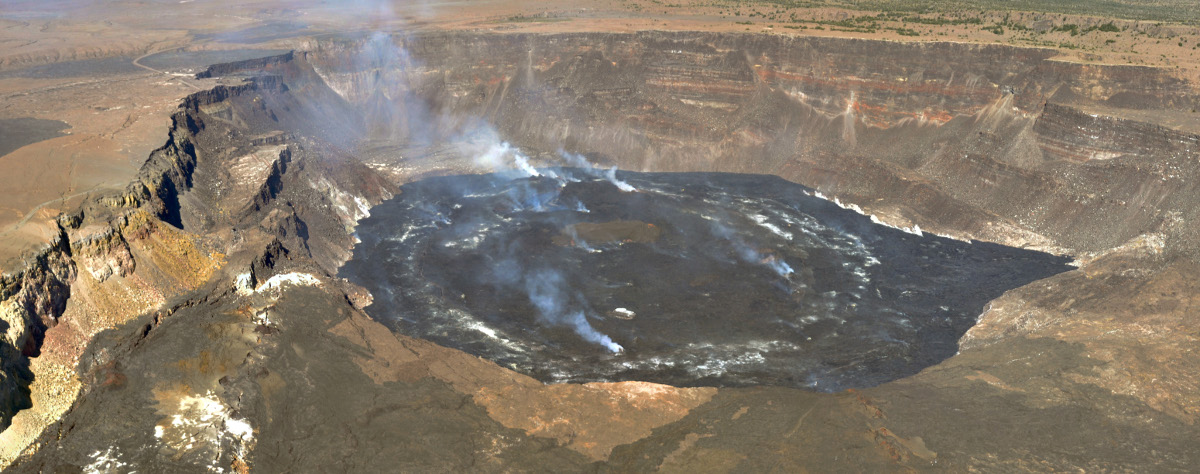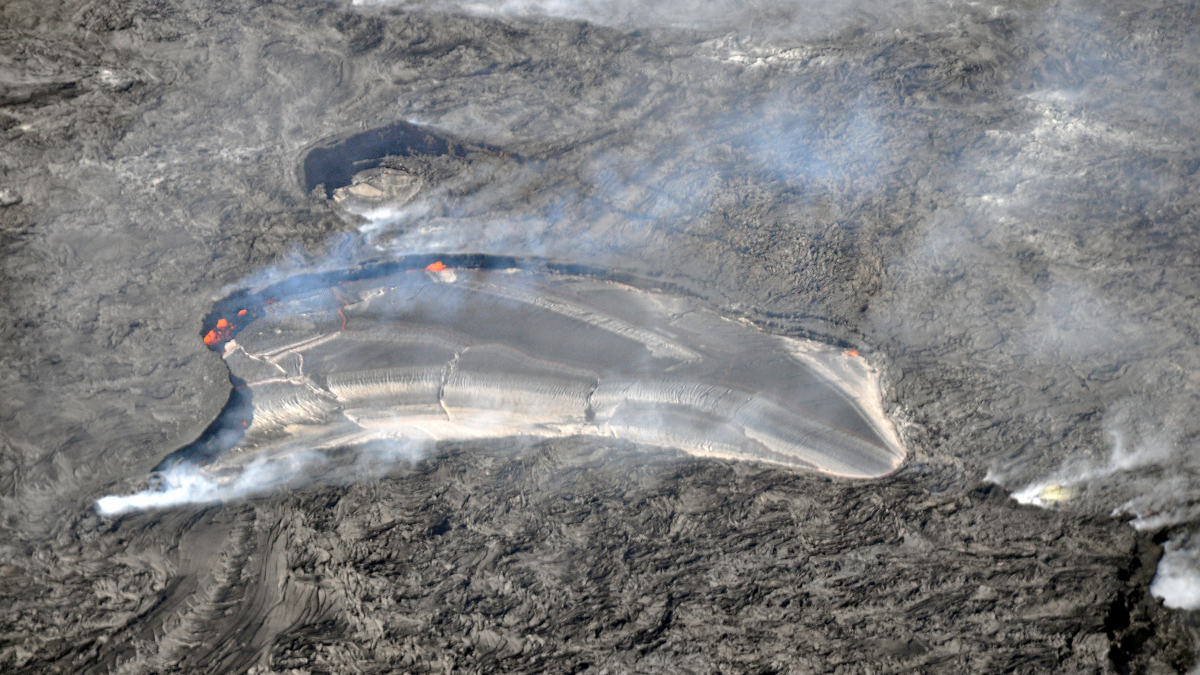
USGS: “This panoramic image was taken during an early morning helicopter overflight on September 12, 2022, and shows the current Halema‘uma‘u lava lake at the summit of Kīlauea. The blocks that dropped down during the 2018 summit collapse events are visible around the central lake. Sections of Crater Rim Drive, which previously circumnavigated the caldera, can be seen on the left side of the image. The degassing on the lake surface occurs from numerous sources, including the main vent (back center of the image), several small hornitos (front center), and around the margins of the cracks in the lake.” (USGS image by L. Gallant)
- The current Kīlauea Volcano Alert Level remains at WATCH, with all lava activity confined to the summit within Halema‘uma‘u crater, in the closed area of Hawai‘i Volcanoes National Park. New photos of the activity were posted by the USGS.
From the Tuesday activity update published by the USGS Hawaiian Volcano Observatory:
Activity Summary: The summit eruption of Kīlauea Volcano, within Halemaʻumaʻu crater, continued over the past 24 hours. All recent eruptive activity has been confined to the crater. No significant changes have been observed at the summit or in either rift zone.
Halemaʻumaʻu Lava Lake Observations: Eruption of lava from the western vent into the active lava lake and onto the crater floor continued over the past 24 hours. The active part of the lava lake showed continuous surface activity. Overflight measurements from September 12, 2022, indicated that the crater floor had seen a total rise of about 143 meters (469 feet), and that 111 million cubic meters (29.2 billion gallons) of lava had been effused since the beginning of this eruption on September 29, 2021.
Summit Observations: Summit tiltmeters recorded relatively little ground deformation over the past 24 hours. Volcanic tremor remains above background levels. A sulfur dioxide (SO2) emission rate of approximately 1300 tonnes per day (t/d) was measured on September 7, 2022.
Rift Zone Observations: No unusual activity has been noted along the East Rift Zone or Southwest Rift Zone; low rates of ground deformation and seismicity continue along both. Measurements from continuous gas monitoring stations downwind of Puʻuʻōʻō in the middle East Rift Zone remain below detection limits for SO2, indicating that SO2 emissions from Puʻuʻōʻō are negligible.
Hazard Analysis: This eruption at Kīlauea’s summit is occurring within a closed area of Hawaiʻi Volcanoes National Park. High levels of volcanic gas are the primary hazard of concern, as this hazard can have far-reaching effects downwind. Large amounts of volcanic gas—primarily water vapor (H2O), carbon dioxide (CO2), and sulfur dioxide (SO2)—are continuously released during eruptions of Kīlauea Volcano. As SO2 is released from the summit, it reacts in the atmosphere to create the visible haze known as vog (volcanic smog) that has been observed downwind of Kīlauea. Vog creates the potential for airborne health hazards to residents and visitors, damages agricultural crops and other plants, and affects livestock. For more information on gas hazards at the summit of Kīlauea, please see (USGS publication). Vog information can be found at vog.ivhhn.org.
Additional hazards include Pele’s hair and other lightweight volcanic glass fragments from lava fountains that will fall downwind and dust the ground within a few hundred meters (yards) of the erupting fissure vent(s). Strong winds may waft lighter particles to greater distances. Residents should minimize exposure to these volcanic particles, which can cause skin and eye irritation.
Other significant hazards also remain around Kīlauea caldera from Halemaʻumaʻu crater wall instability, ground cracking, and rockfalls that can be enhanced by earthquakes within the area closed to the public. This underscores the extremely hazardous nature of the rim surrounding Halemaʻumaʻu crater, an area that has been closed to the public since early 2008.


by Big Island Video News10:00 am
on at
STORY SUMMARY
HAWAIʻI VOLCANOES NATIONAL PARK - New images of the ongoing summit eruption were captured by scientists during a September 12th overflight by USGS.